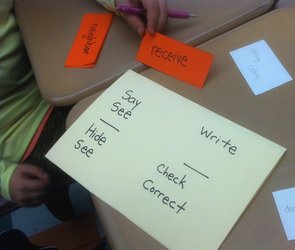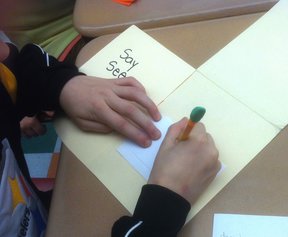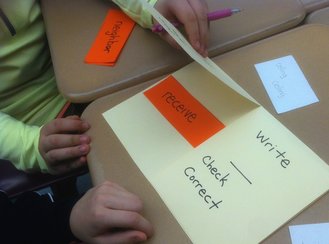|
My August and September 2016 blogs were devoted to the idea of teaching children strategies for spelling unknown words. Specifically I discussed spelling by analogy (using a word that you know as template for spelling a word you don’t know) and spelling by sound (hear the sounds, assign letters and patterns that make those sounds). Today's offering is See the Word Inside Your Head, the strategy accomplished spellers use most often.
Some children develop the ability to “see a word inside their head” naturally. Others do not. To encourage students to build and use a repository of stored words in their brains, teach them to study spelling words using the steps given below. Then, when it comes time to spell words independently during writing (or on a test), remind students to use these steps: see the word in your mind, write the word, and check the word. As teachers, we hope that by intentionally using “see-write-check,” students will later generalize the strategy into the automatic ability to visualize a word, write it down, and then check it against the word stored in their brain dictionary. I have seen variations of the “see the word” strategy in core-reading programs for a couple of decades now. My most recent encounter with it was while perusing the stand-along spelling program Spelling Connections, published by Zaner-Bloser. Spelling Connections presents a three-step strategy for studying spelling words. Here is my two-step variation. 1. Say-See, Hide-See
Here is an example of how I might model my use of this strategy and use a think aloud to explain its workings:
An easily constructed “flip folder” provides opportunities for students to practice the strategy “see the word in your head.” The activity, which can be done independently or with a buddy, is designed for instant error correction. A student spells a word and then checks it for correctness. If the word is misspelled, the student corrects it before moving on to the next word. To make a flip folder, you need a manila folder, a marker, a set of word cards, and stack of blank slips of paper. The activity’s routine mirrors the two-step word study strategy outlined above. Here is a brief description of the routine, which is also presented in the pictures below.
Comments are closed.
|
Mark WeaklandI am a teacher, literacy consultant, author, musician, nature lover, and life long learner.
|




 RSS Feed
RSS Feed